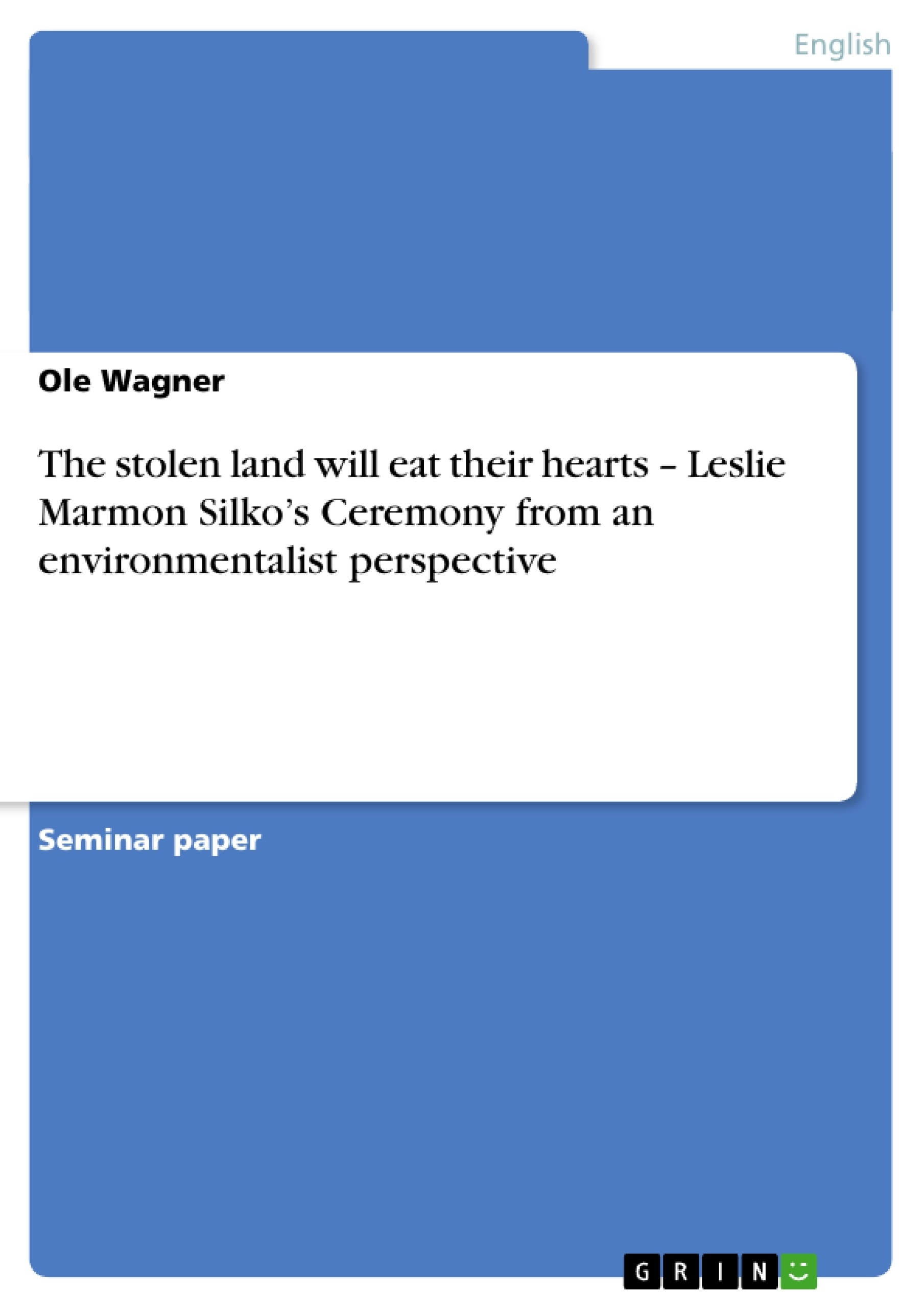Leslie Marmon Silko’s novel Ceremony is not only about Native American culture, it is also about the environment and how different ethnical groups deal with it. Even though they do not intervene in the story’s course, animals (except the cattle Tayo has to find), plants and last but not least the ‘land’ (as a term for all more or less ‘dead’ things in nature, like stones, e.g.) play a crucial role in this piece of fiction. This essay will take a look at the novel from an environmentalist perspective in order to show how nature is treated here by the humans and which effects are caused by this. It will also examine how this plays a role in Tayo’s personal fate.
In the case of Ceremony environmentalism is also humanism. Aboriginal peoples are very often connected with their land and everything in and on it in a way which is quite different from the European U.S. American way of living. Every harm done to ‘their’ land hurts them very much. This is also shown in Silko’s novel and therefore will be taken as a theme in this essay.
In a Native American culture as the Laguna Pueblo’s reality, dream and belief often become mixed. Therefore it will sometimes be necessary here to go beyond the actual events and get involved in what could be called ‘religion’ (even though the focus will mostly be on what really ‘happens’), speaking in Western terms. What is meant here are mainly the stories which are scattered throughout the book. These stories represent traditional Laguna beliefs (the stories themselves reproduced in Silko’s literary modification) and offer a view on nature that is based on harmony and a peaceful living together.
But first this essay will deal with the bad things commited towards the environment, because this way the contrast to the positive actions and interactions with nature that form the second part will be as sharp as it should be seen.
As a last part will serve what can be considered the ‘environmentalist boiling-point’ of the book, the part in which the Native American ecocatastrophe is lifted on a global level.
Inhaltsverzeichnis (Table of Contents)
- Introduction
- Crimes Against Nature
- The Ignorance of the White Man
- Tayo's Mistake
- Native Americans Living in Harmony with Their Environment
- The Nature Helps the People
- Tayo's 'Re-Conversion' - Ts'eh
- The Destruction of the Earth
- Conclusion
- Works Cited
Zielsetzung und Themenschwerpunkte (Objectives and Key Themes)
This essay examines Leslie Marmon Silko's novel Ceremony from an environmentalist perspective, highlighting the contrasting ways in which Native Americans and European Americans interact with nature. The essay aims to demonstrate the crucial role nature plays in the story and its influence on the protagonist, Tayo. It explores the consequences of the Whites' destructive actions on the environment and the Native American culture, emphasizing the interconnectedness between the land and its people.
- The conflict between Native American and European American views on land use and land tenure.
- The impact of the Whites' exploitation and destruction of the environment on both the Native American culture and the protagonist, Tayo.
- The importance of respecting and understanding nature, particularly the traditional Laguna Pueblo beliefs that emphasize harmony and peaceful coexistence.
- The connection between environmentalism and humanism, illustrated by the profound connection Native Americans have with their land and its impact on their well-being.
- The portrayal of the Native American ecocatastrophe as a global issue.
Zusammenfassung der Kapitel (Chapter Summaries)
The first chapter introduces the novel's focus on environmentalism and its connection to Native American culture. It emphasizes the unique relationship between Native Americans and their environment, distinct from the European American approach. The chapter also lays out the essay's structure, starting with the negative effects of human actions on nature and then transitioning to the positive interactions and beliefs of Native Americans.
The second chapter explores the historical and ongoing exploitation of the environment by the Whites. Using specific examples from the novel, the chapter highlights the consequences of logging, hunting, and the destruction of natural resources, particularly for the Laguna people. This chapter also discusses the implications of land theft and the resulting cultural self-doubt experienced by Native Americans.
The third chapter delves into the traditional Laguna Pueblo beliefs about the importance of respecting nature and its role in human life. It contrasts these beliefs with the Whites' ignorance and lack of understanding towards the environment. The chapter further highlights the impact of these conflicting views on the protagonist, Tayo, and his experiences with killing flies and encountering different types of cattle.
Schlüsselwörter (Keywords)
This essay explores the concepts of environmentalism, Native American culture, land tenure, and humanism in Leslie Marmon Silko's Ceremony. Key themes include the conflict between Native American and European American approaches to nature, the impact of exploitation and destruction on the environment and the Native American culture, and the importance of respecting traditional Laguna Pueblo beliefs and their connection to the land.
- Citar trabajo
- Ole Wagner (Autor), 2004, The stolen land will eat their hearts – Leslie Marmon Silko’s Ceremony from an environmentalist perspective, Múnich, GRIN Verlag, https://www.grin.com/document/75058



